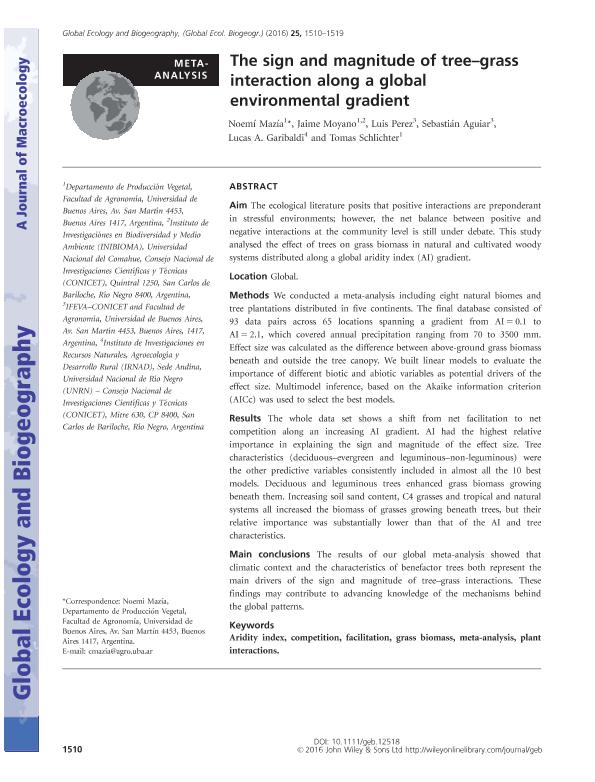Artículo
The sign and magnitude of tree–grass interaction along a global environmental gradient
Mazía, Cristina Noemí; Moyano, Jaime; Perez, Luis Ignacio ; Aguiar, Sebastián
; Aguiar, Sebastián ; Garibaldi, Lucas Alejandro
; Garibaldi, Lucas Alejandro ; Schlichter, Tomás Miguel
; Schlichter, Tomás Miguel
 ; Aguiar, Sebastián
; Aguiar, Sebastián ; Garibaldi, Lucas Alejandro
; Garibaldi, Lucas Alejandro ; Schlichter, Tomás Miguel
; Schlichter, Tomás Miguel
Fecha de publicación:
12/2016
Editorial:
Wiley Blackwell Publishing, Inc
Revista:
Global Ecology and Biogeography
ISSN:
1466-822X
Idioma:
Inglés
Tipo de recurso:
Artículo publicado
Clasificación temática:
Resumen
Aim: The ecological literature posits that positive interactions are preponderant in stressful environments; however, the net balance between positive and negative interactions at the community level is still under debate. This study analysed the effect of trees on grass biomass in natural and cultivated woody systems distributed along a global aridity index (AI) gradient. Location: Global. Methods: We conducted a meta-analysis including eight natural biomes and tree plantations distributed in five continents. The final database consisted of 93 data pairs across 65 locations spanning a gradient from AI = 0.1 to AI = 2.1, which covered annual precipitation ranging from 70 to 3500 mm. Effect size was calculated as the difference between above-ground grass biomass beneath and outside the tree canopy. We built linear models to evaluate the importance of different biotic and abiotic variables as potential drivers of the effect size. Multimodel inference, based on the Akaike information criterion (AICc) was used to select the best models. Results: The whole data set shows a shift from net facilitation to net competition along an increasing AI gradient. AI had the highest relative importance in explaining the sign and magnitude of the effect size. Tree characteristics (deciduous–evergreen and leguminous–non-leguminous) were the other predictive variables consistently included in almost all the 10 best models. Deciduous and leguminous trees enhanced grass biomass growing beneath them. Increasing soil sand content, C4 grasses and tropical and natural systems all increased the biomass of grasses growing beneath trees, but their relative importance was substantially lower than that of the AI and tree characteristics. Main conclusions: The results of our global meta-analysis showed that climatic context and the characteristics of benefactor trees both represent the main drivers of the sign and magnitude of tree–grass interactions. These findings may contribute to advancing knowledge of the mechanisms behind the global patterns.
Archivos asociados
Licencia
Identificadores
Colecciones
Articulos(CCT - PATAGONIA NORTE)
Articulos de CTRO.CIENTIFICO TECNOL.CONICET - PATAGONIA NORTE
Articulos de CTRO.CIENTIFICO TECNOL.CONICET - PATAGONIA NORTE
Articulos(IFEVA)
Articulos de INST.D/INV.FISIOLOGICAS Y ECO.VINCULADAS A L/AGRIC
Articulos de INST.D/INV.FISIOLOGICAS Y ECO.VINCULADAS A L/AGRIC
Citación
Mazía, Cristina Noemí; Moyano, Jaime; Perez, Luis Ignacio; Aguiar, Sebastián; Garibaldi, Lucas Alejandro; et al.; The sign and magnitude of tree–grass interaction along a global environmental gradient; Wiley Blackwell Publishing, Inc; Global Ecology and Biogeography; 25; 12; 12-2016; 1510-1519
Compartir
Altmétricas



